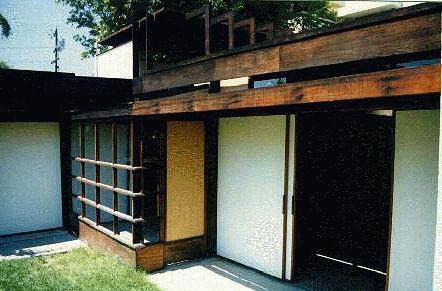Rudolph Schindler's house in the West Hollywood of 1920, when neither the Dream Factory nor houses like this existed. 
Studying with and working under both Otto Wagner and Frank Lloyd Wright, this was the Viennese architect’s first substantial statement of direction.
Designed for himself, his wife and another couple with whom they shared the timber and concrete tilt-slab built house, each of the couples had their own wing, their own studios, and their own courtyards in the cunningly designed three-wing pinwheel spinning out of a common kitchen.
Not bad for a house built on the sort of budget with which people today might spend on a new bathroom.
“The residences of Schindler are intimately related to the earth,” wrote Pauline Gibling Schindler, discussing her husband in a1932 issue of Creative Art Magazine. “Meant for a life which flows naturally from the house out of doors, but which at the same time maintains an intense privacy, they are woven into their gardens and the gardens themselves become rooms.”
Privacy. Light. Sunlight carefully screened and modulated. Spaces opening up to private grounds, and to each other. And naturally, all the furniture was carefully designed to complement the scheme (original couch below, not in setting; original setting above, not with Schindler furniture).
 Nothing like it had been seen before in Southern California. And very little since.
Nothing like it had been seen before in Southern California. And very little since.
Head to this site and scroll down, and you’ll get a feel for the entrance sequence to the (now empty) house that Schindler so masterfully set up, and much more—including a tiny but fascinating bathroom.
And to this one to find Schindler’s considered opinion of how much (or how little) the man (or woman) earns whose “imagination must enable him to take a pile of building materials and create an organism which will function and live.”







1 comment:
Schindler seems to be back in favour again, which is a good thing.
Post a Comment